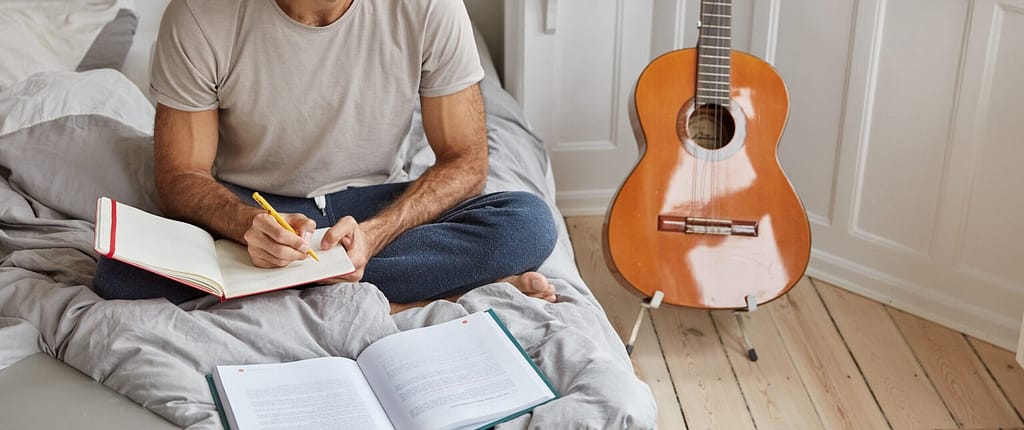Lets Start the Journey
LESSON PLAN FOR BEGINNERS
CHOOSE YOUR METHOD
TYPES OF ACOUSTIC GUITAR

So you already have idea what acoustic guitar is. When you search for acoustic guitar, you will find varieties of shapes and sizes of guitar which have impact on the sound and performance of the guitar. Every guitar company tries to include their individual unique properties through the design of an acoustic guitar so it sounds more soothing than before. Considering that lets have a general idea on different types of acoustic guitar which are common and popular for their own characteristics.
CLASSICAL GUITAR

The classical guitar, also known as the Spanish guitar, is predominantly used in classical music and various other styles. These guitars have bodies made of wood and typically feature strings crafted from gut or nylon.
A key characteristic of classical guitars is their smaller dimensions and slightly larger soundbox compared to standard guitars. They are easily recognizable by their open slotted tuners. The neck of a classical guitar is generally broader, providing a more spacious playing area.
Classical guitars are particularly popular in European traditional orchestral music. Renowned musicians like Andres Segovia and Christopher Parkening favor classical guitars, which are more popular than commonly believed. Many professional guitarists prefer classical guitars for their unique sound and the focus on playing melodies rather than strumming chords. Each individual string is played separately to craft the music for a specific song.
For beginners, classical guitars may not be the best choice, as they are primarily designed for classical players. The flat fretboard of these guitars can make playing chords challenging, as it goes against the natural curvature of the hand. Moreover, the wider gap between strings may not feel comfortable initially. Classical guitars produce a softer, balanced sound due to the nylon strings, making them ideal for Spanish, fingerstyle, and flamenco players. If you enjoy rhythmic strumming and playing chords, this might not be the best guitar for you.
THE DREADNOUGHT

The dreadnought body style stands out as the most popular among acoustic guitars. Originating in 1916 through a collaboration between Martin and the retailer Oliver Ditson Company, this design is celebrated for its broad, full-sized body that delivers a robust, balanced sound with a blend of deep bass and crisp treble notes.
Ideal for strumming chords or picking out melodies, the dreadnought guitar is versatile across various genres, from folk and rock to country. Its larger body and extended scale length contribute to its ability to project a louder sound compared to other guitar shapes, enabling players to perform more dynamically and stand out amidst accompanying instruments. Additionally, its strong bass response fills out the musical spectrum, yielding a lush sound when played solo or within an ensemble.
Thanks to its diverse attributes, the dreadnought guitar appeals not only to seasoned professionals performing on stage but also to beginners embarking on their musical journey.
JUMBO

Among steel-stringed acoustic guitars, the jumbo stands out for its impressive size. This translates into powerful volume, extended sustain, and a rich tonal depth reminiscent of dreadnought guitars. Jumbos are distinguished by their fuller, more rounded lower bout compared to other acoustic body styles.
Often nicknamed the “Cowboy” guitar, jumbos boast a generous amount of wood, contributing to their big, bold sound with a pronounced bass presence. This makes them a favorite for rhythm guitarists who want to provide a strong foundation for lead melodies or other instruments.
But the jumbo’s appeal goes beyond volume and tone. Maple for the back and sides enhances clarity, allowing each note to be heard distinctly within a chord. This characteristic makes jumbos well-suited for playing full chords, and their tonal balance – a combination of deep bass, a slight mid-range dip, and crisp highs – has earned them a reputation as “EQ-free” guitars among sound engineers.
PARLOR

The parlor guitar’s name reflects its Victorian-era origins. In those days, families entertained guests in a special room called a parlor, and the guitar was a popular choice of instrument for these gatherings.
While it might seem counterintuitive, the parlor guitar was actually the largest acoustic guitar available before the 1870s. The need for bigger guitars simply didn’t exist. The 20th century saw the rise of the parlor guitar we know today: a slender instrument with a distinctive slotted headstock, rounded shoulders that meet the body at the 12th fret, and a smaller overall size.
With its nostalgic character and bright, crisp sound (when played with steel strings), the parlor guitar evokes a sense of vintage charm. Opting for nylon strings instead delivers a mellower, warmer tone, similar to a classical guitar. This versatility, combined with its lightweight design, makes the parlor guitar a perfect companion for beach bonfires, camping trips, or simply enjoying music on the go. The unique body shape, bracing pattern, and other construction elements contribute to a well-balanced sound with a focus on the midrange frequencies.
Grab Your Guitar

Acquiring your inaugural acoustic guitar marks one of life’s cherished moments. However, it can also be a tad bewildering. Before embarking on your journey to procure your first guitar, it’s imperative to establish your budget. Acoustic guitar prices range from a modest $30 to a hefty $5000, and beyond. For novices, splurging on an expensive model is unnecessary. Opting for a budget between $50-$150 is typically advisable, though if your finances permit, there’s no harm in investing more.
Selecting a guitar that captivates you at first glance and feels comfortable in terms of size and fret profile is paramount. Seeking guidance from an experienced guitarist during your purchase is invaluable. The construction of an acoustic guitar’s body holds significant importance, impacting its tuning stability, fretboard resilience, string setup, and other critical factors. Thus, acquiring a comprehensive understanding of these technical aspects before purchasing your first guitar is essential.
While individual preferences may vary, steel-stringed guitars like Dreadnought or Jumbo are popular choices for beginners due to their versatility and durability. Stick to these two types, and you’ll encounter various brands offering similar options. Amidst the array of choices, it’s crucial not to be overwhelmed. Remember, the guitar will be yours, and your comfort and enjoyment should be paramount in your selection process.
Steel-string acoustic guitars come in various sizes, so choose one that suits your physique. Those with larger hands may prefer guitars with thicker necks, while individuals with smaller hands may opt for smaller or thinner-necked models. Once you’ve made your selection, it’s time to string and fine-tune your instrument. Visiting a local shop for string installation and adjustments is advisable. Proper adjustments ensure optimal intonation, prevent neck bending, and ensure the nut and saddle function seamlessly, facilitating comfortable tuning stability and effortless strumming or fingerpicking.
7 TIPS TO CONVINCE PARENTS

1. Explain the benefits: The first step is to showcase the benefits of learning guitar. Learning an instrument can improve memory and increase coordination. improved hand-eye coordination, enhanced creativity, and stress relief. Learning guitar can improve skills, boost creativity.
2. Share success stories: Show them examples of successful musicians who started learning at a later age. Share success stories of adults who have learned guitar later in life and how it has positively impacted their lives. This can help alleviate any doubts or concerns they may have.
3. Highlight the fun factor: Learning guitar can be a fun and enjoyable activity, and parents can bond with their children by learning together. explain how learning guitar can be a fun and fulfilling hobby that will bring joy and relaxation to their lives. Suggest learning together as a family activity. This can be a fun and bonding experience for everyone involved.
4. Emphasize the convenience: With online resources and virtual lessons, learning guitar can be done from the comfort of their own home. Learning guitar can now be done through online lessons, making it easier and more accessible for busy parents. There are plenty of resources available, such as instructional books, videos, and apps, that can make learning guitar more manageable and enjoyable.
5. Offer to help: Offer to assist with finding a suitable guitar and resources for learning, and offer to practice together. Express how much it would mean to you to share this experience with them and how grateful you would be for their support.
6. Address any concerns: If parents are worried about the cost or time commitment, offer solutions such as budget-friendly options suggest finding a used guitar or borrowing one from a friend or flexible lesson schedules. If they have any specific concerns, address them and provide solutions.
7. Be patient and understanding: Learning a new instrument takes time and effort, so be patient with them and offer your support and encouragement throughout. Learning guitar is a new and exciting challenge that can bring a sense of accomplishment and fulfillment, even for adults.



